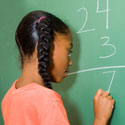Science Through Children's Literature
by Sharon
(Leavenworth, Kansas)
Product: Science Through Children's Literature: An Integrated Approach, by Carol M. Butzow and John W. Butzow
Subject: literature-based science
Levels Used: 4th grade and 1st grade
Dates Used: 2009
I am glad I am taking the time to use this book with my two youngest children. The first part of this manual explains the developmental abilities (based on Piaget) of children under age eight as well the differences between traditional and contemporary teaching methods for science instruction. It then explains every aspect of integrating children's literature into science instruction, right down to how to judge a suitable book, plan activities and lay out concepts being taught.
You can write your own units for older children or add extensions to incorporate older students after you have read the first section. That helped me see where the authors were headed, too. However, the real help was the rest of the book.
They don't just give you the information needed to write your own science units. They supply over 30 units divided into the categories of life science, earth & space science and physical science. For example, students read The Tiny Seed, by Eric Carle while studying seed distribution, conditions favorable to germination and growth and the life cycles of a flowering plant. They filled a nylon stocking with shavings from the rabbit cage and some grass seeds. The tasty recipe for "crunchy seed candy" is now a beloved treat for everyone. I never would have thought of reading the backs of all my seed packages to learn how each plant was different or alike.
How about math, too? Read through seed catalogs and figure out how many seeds you need for how much space. Then find out how much the right amount of seeds will cost for next year's garden. There are other also suggested books like Legend of the Bluebonnet, by Tomie dePaola. Even songs like "Edelweiss" from the Sound of Music were added into our studies.
My 4th grade student also is diagraming the parts of the flower, but I added that so that she could keep at her level. Adding stuff for an older student seems easy when you have a guideline and lots of pre-existing ideas to choose from. You don't have to do them all, but your child might want you to do them all.
I am no science teacher, either. These science units are all well-written with diagrams and so many great ideas. Once you have a method, it isn't hard to add more for an older student. The kids both enjoy science and the oldest gets to read to the youngest. I am glad we are trying this approach. This is fun!!!
I must admit that I had this book in my closet for a few years before I mustered the courage to try it. I thought I was just too busy to take on something kin to a unit study. It can be time-consuming; I admit. There are projects and reading and art and exploration and music and so much more. That takes time. Also, the units are for young children. I brought my 4th grader into the studies, but had to add information for her.
You Might Also Like:

|

|

|
| Read More Homeschool Curriculum Reviews! | View Sample Homeschool Schedules and Create Your Own | Check Out these Homeschool School Rooms |